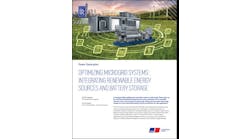Net metering and microgrids can go hand-in-hand, but first you have to do your homework.
Across the country, utilities are challenging net metering projects and laws, resulting in time-consuming delays and expensive charges and rate adjustments for some —and thwarted net metering projects for others.
Utilities successfully challenged net metering in Nevada, resulting in high rates that make it uneconomic for the producer, says Chandler Sherman, public affairs manager for SolarCity. And California recently tweaked its net metering regulations in response to requests from utilities, but mostly kept the practice intact.
“The California Public Utilities Commission’s decision in keeping net metering with minor modifications and rejecting the proposal from utilities to impose fixed charges, will be watched closely by other states,” says Brian Nese, a partner in the Energy Development group and the Renewable and Thermal Energy Initiatives at Stoel Rives.
Hawaii and other states are also re-evaluating their net metering laws.
“Microgrid owners need to ask questions and be sure of what they’re getting into with their utility,” says Sachu Constantine, director of policy, Center for Sustainable Energy. Some utilities understand and support net metering, while others impose fees and rate changes that undermine the value of distributed generation, he says.
Under net metering, your meter runs backward when you feed your excess energy to the grid. A number of states have in place net metering laws that require utilities to take the energy and run the energy producer’s meter backward. But that doesn’t mean the utilities like these laws.
“There’s a longstanding discomfort on the part of utilities with net metering,” says Constantine. “Utilities are used to controlling all the generation and services provided to the grid, and net metering represents a way for customers to have more independent choice. It presents a management problem for utilities.”
Action to take in advance
Before you plan on net metering, be sure you:
- Find out if your utility is friendly to net metering and if it has net metering customers. If possible, you might consider talking to existing customers.
- Check to see if utilities are challenging net metering in your state. Talk to both your utility and renewable energy advocates in your state to ensure you understand what’s happening on the regulatory level.
- Make sure you understand all the costs. Are there interconnection charges?
- Even in states that strongly support net metering — New York, for example — individual utilities may impose extra charges or switch your rate classification in ways that undermine your ability to cost-effectively net meter.
- If you want to use energy storage to run your meter backward, check with your utility to see if it qualifies as renewable energy. Some utilities argue that stored energy may include some fossil fuels and shouldn’t be net metered.
Utilities that oppose net metering argue that costs are not being allocated fairly, says Josh Sturtevant, an associate in the Energy Group in Sullivan & Worcester’s Washington, D.C. office, who specializes in energy project development.
“They’re arguing that if you are net metering and don’t have the same service charges and fees as others, you’re not sharing in the costs of the grid,” he says. Renewable energy advocates, on the other hand, argue that producers should be compensated for the environmental benefits of renewable energy.
For microgrid developers and owners, net metering can be an important tool, says Constantine. And for utilities, microgrids can be just as important.
In the past, microgrids were seen as independent of the grid, he says. “But more and more, we think of microgrids as grid-tied assets.” They can help support the grid during periods of stress. For example, some Native American reservations ramped up to help support the larger grid last summer when fires in California prompted grid shut-downs.
“Net metering is really important, whether a microgrid is served by a utility or third party. The idea of net metering is to balance the inflow and outflow of energy,” says Constantine.
Batteries, net metering and microgrids
If a microgrid produces more solar than the facility needs, for example, net metering allows the producer to send the excess energy to the grid, he says. Even when microgrid owners have battery storage abilities, they sometimes opt to use net metering instead of storage when it’s more cost effective.
Blue Lake Rancheria. Credit: Siemens
In California, Blue Lake Rancheria is negotiating net metering for a microgrid project, and has discovered that the utility, PG&E, doesn’t accept energy storage as a net metering source, says Kurt Meyers, project manager and market lead at Idaho National Laboratory, which is working on the Blue Lake project.
“They will do net metering as long as it’s coming from a PV source, but can’t net meter if it goes through a battery,” he explains.
A spokeswoman for PG&E confirmed, saying that energy storage can only participate in net energy metering if the storage device can charge solely from the renewable generator.
“Energy storage devices that can also charge from the grid cannot participate in net energy metering, since the grid includes generation sources that are non-renewable,” she says.
Utilities are also worried that generators will store grid electricity when it’s inexpensive and sell it back to the utility when rates are high, adds Constantine.
If you’re a microgrid developer or owner interested in net metering, beware. You could encounter technical, financial and political challenges from your utilities. If you don’t do your research, you may find yourself surprised and angered by sudden rate changes like those that that have nearly shut down the rooftop solar industry in Nevada.
Learn more about net metering — and other issues that impact microgrid economics — by attending the Microgrid Knowledge conference in Manhattan May 19.








